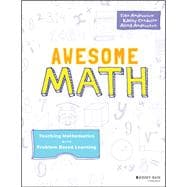Help your students to think critically and creatively through team-based problem solving instead of focusing on testing and outcomes.
Professionals throughout the education system are recognizing that standardized testing is holding students back. Schools tend to view children as outcomes rather than as individuals who require guidance on thinking critically and creatively. Awesome Math focuses on team-based problem solving to teach discrete mathematics, a subject essential for success in the STEM careers of the future. Built on the increasingly popular growth mindset, this timely book emphasizes a problem-solving approach for developing the skills necessary to think critically, creatively, and collaboratively.
In its current form, math education is a series of exercises: straightforward problems with easily-obtained answers. Problem solving, however, involves multiple creative approaches to solving meaningful and interesting problems. The authors, co-founders of the multi-layered educational organization AwesomeMath, have developed an innovative approach to teaching mathematics that will enable educators to:
- Move their students beyond the calculus trap to study the areas of mathematics most of them will need in the modern world
- Show students how problem solving will help them achieve their educational and career goals and form lifelong communities of support and collaboration
- Encourage and reinforce curiosity, critical thinking, and creativity in their students
- Get students into the growth mindset, coach math teams, and make math fun again
- Create lesson plans built on problem based learning and identify and develop educational resources in their schools
Awesome Math: Teaching Mathematics with Problem Based Learning is a must-have resource for general education teachers and math specialists in grades 6 to 12, and resource specialists, special education teachers, elementary educators, and other primary education professionals.








